Technostress is typically characterized as a contemporary form of adaptation-related ailment resulting from difficulty in handling new computer technologies. Technostress impacts mental well-being, presenting itself either as resistance to embracing computer technology or an excessive identification with the same.
In the constantly changing terrain of technological progress, technostress has become a notable factor affecting mental health. As we maneuver through the complexities of contemporary life entwined with ongoing technological shifts, it is essential to grasp the deep-reaching consequences technology can have on our mental well-being.
Decoding Technostress – In Detail Overview
Technostress is the unease, tension, or discomfort that arises when an individual feels overwhelmed by new technology. This sensation occurs when an individual struggles to adapt and acquire the skills to use technology positively and efficiently. Also, under the circumstances, when they are made to spend longer hours on the net. They are always connected over gadgets. For example, results from research in Italy indicated that technostress was related to work-family conflict and psycho-physical distress, mediated by the fear of COVID-19 and always being jammed up in a working environment.
Signs You Are Struggling With Technostress

In a world where dependence on digital devices, social media, and continuous connectivity is growing, consequential technostress can have negative effects. Research highlights three main indicators of technostress that one should be vigilant about:
Techno Chronic
A prominent indicator of technostress is the persistent urge to check digital devices frequently. Studies indicate that the constant need for connection, whether for professional or recreational purposes, signifies addictive tendencies. This behavior may manifest as discomfort when away from devices, reaching for your phone in social situations, or disrupting crucial tasks to address notifications.
Moreover, the surge in remote work has led many individuals to feel constantly engaged in their professional responsibilities. Thus leading to burnout, a disruption in work-life equilibrium, and a decline in focus and productivity.
Being Physically Overwhelmed
Studies indicate that technostress manifests physically in several ways. Prolonged screen time contributes to health issues such as headaches, eye strain, body aches, and disturbances in sleep patterns. These symptoms are frequently associated with inadequate ergonomic practices, prolonged screen exposure, and the disruption of circadian rhythm caused by the blue light emitted by devices.
Technostress is closely tied to increased anxiety and heightened stress levels. The pressure to be constantly accessible for work-related messages and emails, 24/7, can keep individuals in a perpetual state of stress. Thus negatively impacting physiological aspects such as compromised brain and immune system functioning.
Suffering Relationships
Although technology can connect people, it can also result in disconnection. Studies indicate that excessive dependence on digital communication can impede face-to-face interactions and foster a sense of isolation. Frequent checking of devices in social settings or prolonged engagement with social media may distance you from those physically around you.
The temptation of escaping into the digital realm can lead to “phubbing,” where screens take precedence over personal relationships. Research suggests that a fear of missing out online often motivates such phubbing behavior.
Tips To Deal With Technostress

There are applications that offer users the ability to track their online activity and take breaks from constant connectivity. Evidence suggests that people struggle to evade the pressures imposed by technology. The escalating use of smartphones and mobile apps has significantly heightened our dependence since the inception of the term “technostress.” however, when there is a will, there is always a way! These are some of the tips to deal with Technostress in the fast-developing world:
Establish Specific Break Times And Adhere To Them
This involves monitoring the duration spent in front of a screen. It’s a mutually beneficial arrangement, as you plan breaks for connectivity while gaining increased awareness of your screen time. Allocating specific time for social media usage is one of the most effective ways to overcome technostress. If daily interaction with social media is necessary, ensure that phone notifications are disabled. For a more significant impact, consider removing social media apps from your mobile devices.
Always Power Off Your Device When Not In Use
Eliminate unnecessary distractions while working, during breaks, and before bedtime. Incorporate the habit of switching off your phone multiple times throughout the day.
Practice Taking Notes On Paper
If you prefer not to involve yourself with another app or system to organize your tasks and thoughts, opt for the traditional method of jotting things down on paper.
Prioritize Your Time Off The Screen
Minimize your unnecessary communication by sorting out non-urgent messages and allocating dedicated time to respond when you have availability. This pertains to both professional and personal communication.
Always Focus On One Task At A Time
Avoid multitasking with technology, close multiple windows, and concentrate on the current task. If using platforms like Slack or other online project management tools, establish clear limits on when you will be available.
Digital technology stands as a significant agent of transformation, with much of its impact being positive. For instance, online communication has played a crucial role in maintaining connections among individuals separated physically during the pandemic. Technology proves advantageous, yet its detrimental effects may surface when individuals engage with it in an unhealthy manner. In a tech-driven world, the repercussions of technostress persist for people. It becomes imperative for them to acquire the skill of disconnecting.



